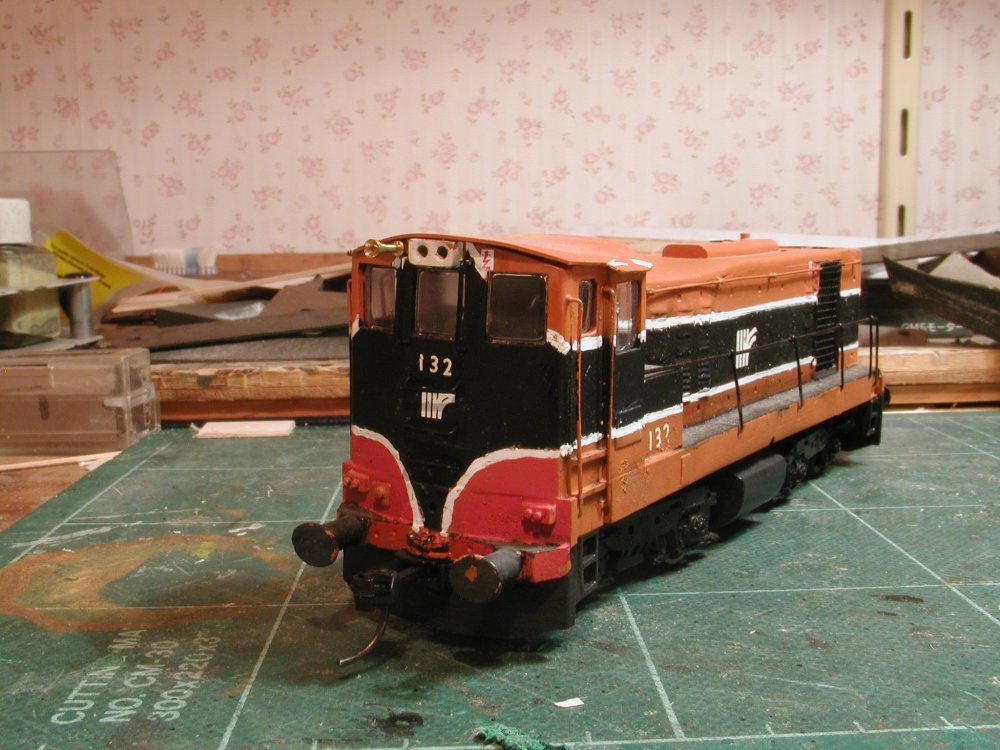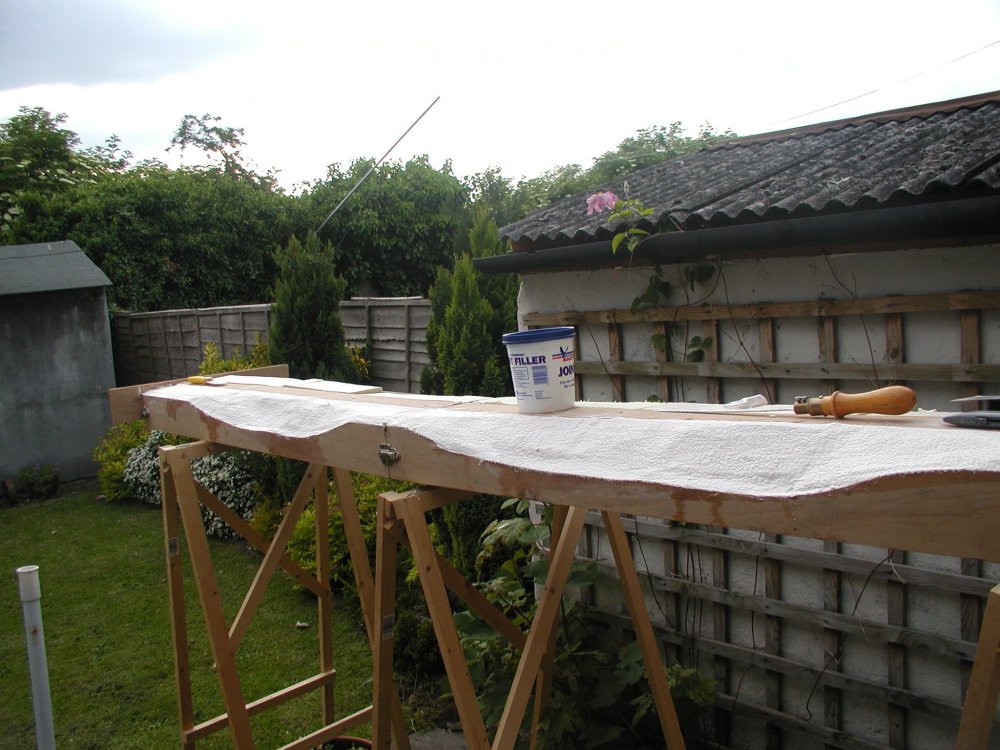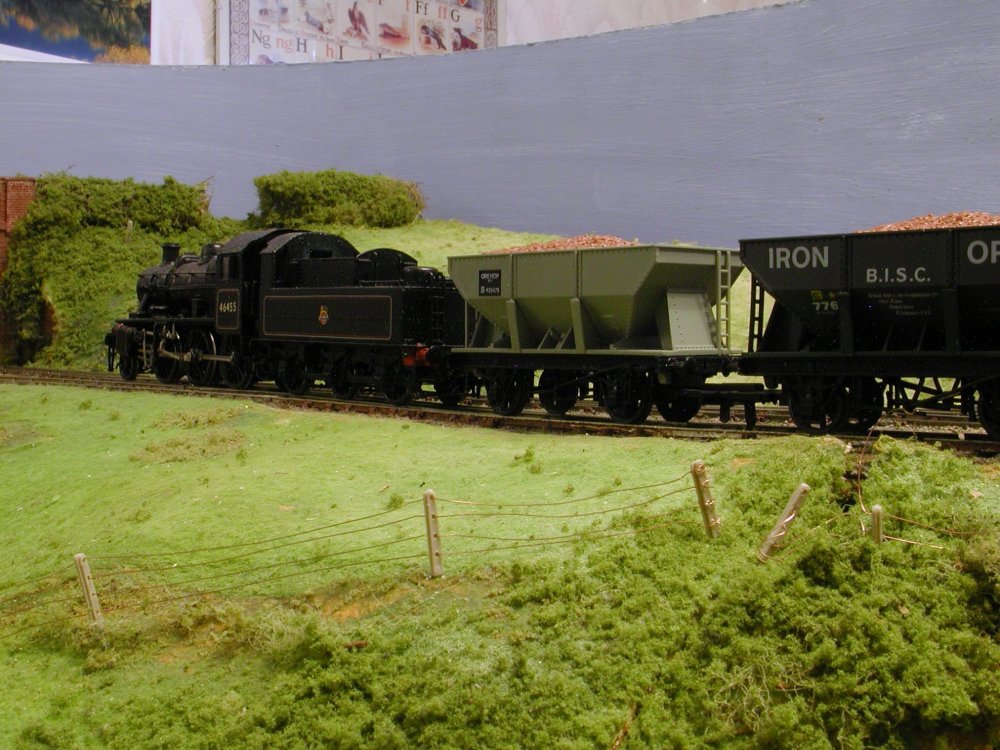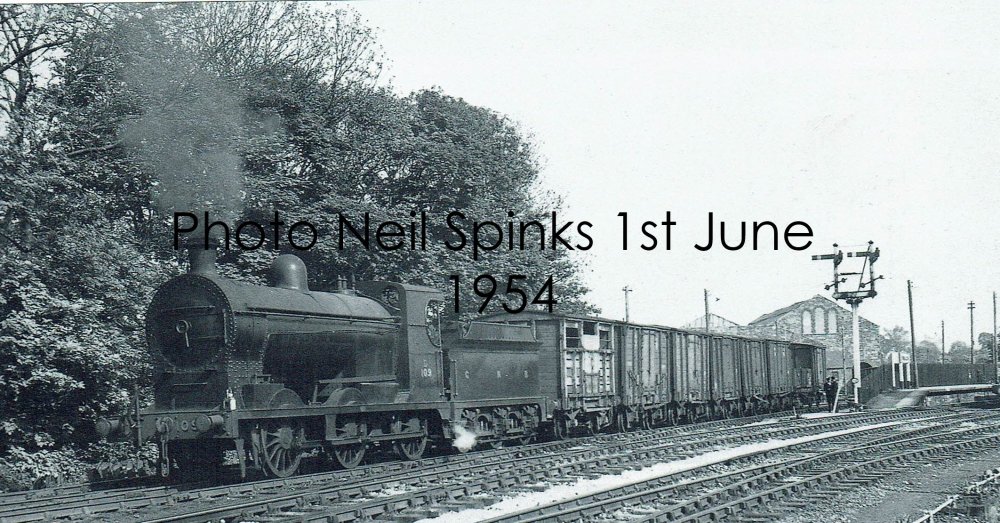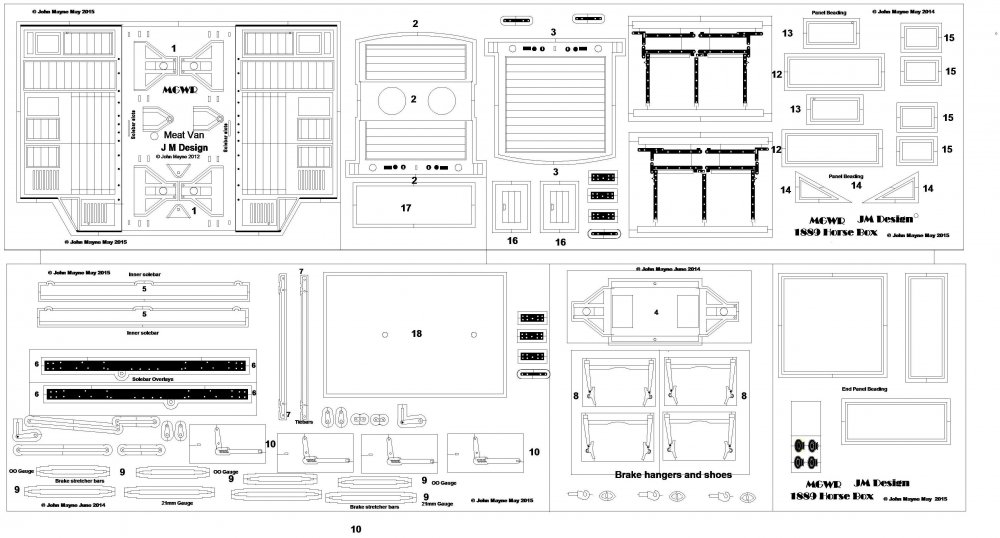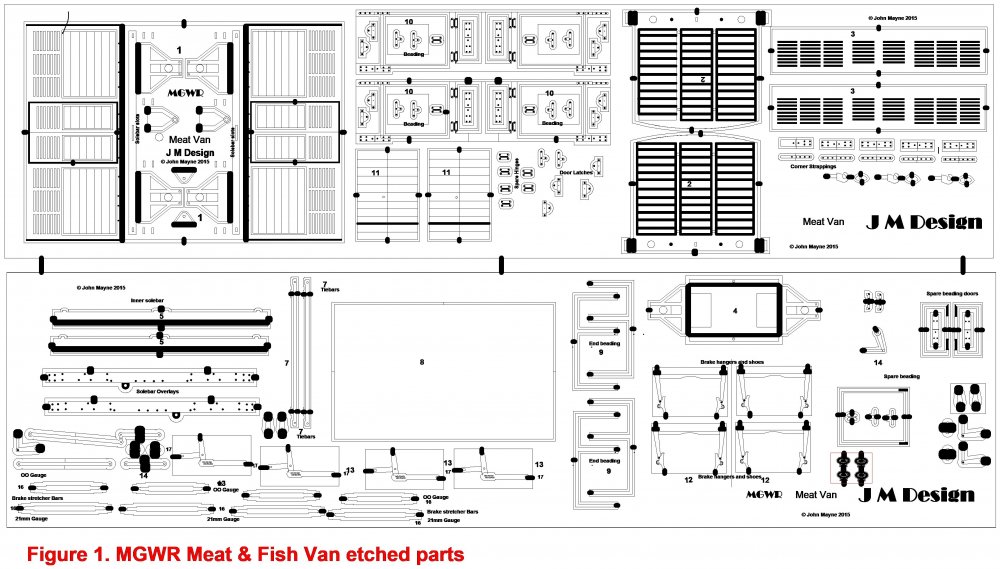-
Posts
4,872 -
Joined
-
Last visited
-
Days Won
119
Content Type
Profiles
Forums
Events
Gallery
Blogs
Store
Community Map
Everything posted by Mayner
-
I built a pair of 121s using the MIR whitemetal kits and Athearan chassis about 20 years ago, the Rails 3D printed body builds i to a better model despite the limitations of the 3D printing process. The 3D printing process seems to be a good way to go for layout stock that fits the 2' rule where the viewer is looking at the entire train than an individual model. Kirley recently built some convincing 4w IE timber wagons using the Rails 3D printed body in conjunction with old Triang-Hornby Presflo wagon underframes. The correct bogie sideframes makes a huge difference to the 121 compared with the stock Athearn sideframes. Whitemetal MIR 121 c-2000 Athearn SW1500 chassis. My standard of painting an d lining still has a long way to go
-
Definitely seems appears to be a sequel to "Narrow Gauge Album", the original is definitely worth while seeking out in second hand bookstores or Amazon for its account of the early days of the preservation movement and stories of railway operation. Following on on Noel's suggestion a series of pictorials of lines in the Midlands would be nice, perhaps combining colour and black and white photos with condensed versions of J P O'Dea's John O'Meara's, and N J McAdams IRRS papers would really bring the operation of these lines in the 1950s & 60s to life. The IRRS papers are very useful from a modelling perspective usually including details of motive power and traffic patterns and station track layouts. John O'meara published papers on the Meath Line and Tuam Branch, NJ McAdams The Mayo Line and J P O'Dea just about everywhere else including the Banagher & Ballaghdereen Branches The more recent Ian Allen/Midland Publishing Irish Railway Pictorial series contain high quality photos through from the steam age to the present including albums on the Great Southern Railways, Great Northern Railways, a number of regional and narrow gauge albums.
- 6 replies
-
- 1
-

-
- narrow guage
- co donegal
-
(and 2 more)
Tagged with:
-
During the 1950s the GNR introduced the "Derry Vacuum" Dublin-Strabane-Foyle Road express goods service for urgent overnight traffic to Donegal. The Vacuum appears to have been initially an AEC railcar set hauling a couple of fitted vans and container wagons, before morphing into the Derry Goods of the UTA/NIR era. This seems to have been the first fully fitted express freight train in Ireland the precursor of the modern Liner Train running close to passenger train speeds with power braking on all wagons. JHB may be able to correct me but Dundalk appears to have been what the Americans call a division point for Dublin-Belfast operation with NIR crews operating cross border freight services. This would have been tied up with pre-1993 Customs examination and working arrangements with the CIE & NIR Unions. This lead to trip working from Dundalk to Adelaide with quite varied wagon consists (keg, container, bulk cement, fertiliser in the one train) compared to the more uniform wagons consists south of the Border. One of the more interesting workings were loose coupled trains carrying Harp Larger traffic between Dundalk and Adelaide operated into the early 80s. These trains included the unusual combination of modern 4w keg wagons and 30t brake vans. Loose coupled operation ceased when the keg traffic was transferred from the station to Barrack St Yard. The early 90s was probably the busiest time for cross border freight operation when Freightliners Ltd ceased their Holyhead-Dublin sailings and attempted to serve Dublin by a rail connection off its Liverpool-Belfast sailings. This resulted in Freightliners chartering two daily return Belfast-Dublin liner trains to handle traffic to and from the South.
-
Tony: The different levels make it much more visually interesting compared to a conventional flat baseboard and helps to make sense of the unusual and distinctive split level goods/shed grain store. The track that leads from the y turnout into the goods shed should be long enough for a loco and at least one or two wagons otherwise it will be difficult to run round while shunting the yard. The low relief goods shed looks really effective and there is no doubt that the model is based on Omagh. I would be inclined to to curve the backscene behind the shed rather than leave it at a 90 angle.
-
For years I thought that I had imagined seeing a big blue steam loco until I saw a colour slide of 171 about 10 years later and borrowed a copy of Colin Boockocks irish Railway Album from the library complete with several photos of 207. Ours was firmly a car and bus family, my first train ride was around 69 or 70 in a compartment coach with wooden paneling behind a black noisy diesel from Killiney to Tara Street.
-

EM/OO Fine standards applied to Irish 5'3" gauge track.
Mayner replied to Mayner's topic in Irish Models
Both Steam Era Models (Black Beetle Motor Bogies) & Hollywood Foundry (Bull-Ant) in Australia will supply 21mm gauge motor bogies & chassis to order. Hollywood Foundry will produce chassis to any gauge upwards of N including 12mm for Irish 3' and English Broad Gauge for modelers who are in to that sort of thing. -

EM/OO Fine standards applied to Irish 5'3" gauge track.
Mayner replied to Mayner's topic in Irish Models
The choice between 21mm and OO is really about whether a person draws the more satisfaction from the technical and physical challenges of building to an odd-ball gauge or building and operating a layout using rtr stock. For someone wanting to build a large layout within a reasonable time frame or a continuous run in a restricted space OO or even EM is probably a better option than 21mm gauge. Mounting the layout near eye level and using Bullhead or Peco Code 75 track will reduce the narrow gauge look of OO gauge track. It should be possible to build an continuous run 21mm layout to OO standards with No 2 or No 3 radius curves and NMRA 110 wheels , but the gauge would have to be reduced below 21mm to provide sufficient splasher and cylinder clearance with steam locos which is probably not worth the effort, though a couple of modelers model Irish broad gauge on EM track. (Templot) Martin Wynne has specifies a track gauge of 20.2mm with a 1mm flangeway gap and a minimum recommended radius of 1000mm for Irish broad gauge track laid to EMGS standards. The gauge was presumably reduced the risk of EMF wheels fouling steam loco splashers and coupling rods/crossheads on outside cylinder steam locos. The flangeway clearances would have to be increased to 1.5mm and wider NMRA wheels and the gauge narrowed further to avoid the problem of the minimum radius is reduced to 600mm. I don't know if any 5'3" gauge modeler has reduced the gauge to 20.2mm , clearances are tight but workable with Gibson & Ultrascale EMF profile wheels wheels. The distance between splashers/coupling rods cross heads on outside cylinders would have to be increased or the gauge reduced if you intend using steam locos with NMRA 110 profile wheels. NMRA 110 profile wheels with b-b set 1t 19.3 fouling splashers on SSM J15. -

EM/OO Fine standards applied to Irish 5'3" gauge track.
Mayner replied to Mayner's topic in Irish Models
North Yard in New Zealand supply a 28mm 2.03dia blackened brass pin point axle @ $0.90NZ (app £0.48) Item 471 delivery approx 2 weeks postage app $15-20NZ per order. Northyard.co.nz North Yard wheels and axles are mainly intended for modelling S scale use. I have used these axles successfully with Alan Gibson and Hornby wheels in 21mm gauge and with North Yard wheels in OO. An alternative is to extend a standard 26mm axle by cutting and sleeving with 2mm inside diameter brass tube available from Eileen's Emphorium in the UK. I haven't worked out mimimum track centers for 21mm, distance will vary subject to a number of factors including track alignment, lineside structures, min vehicle width and length. The MGWR loading gauge specified a minimum of 6'2⅝" rail centre-rail centre between tracks, very close to the nominal 6' way or 24mm in 4mm Distance between running roads needs to be increased above a min 24mm on curved trackage and between running lines and yard trackage and between tracks in yards where people were likely to be working. I ran into problems with side swiping between 60'X9'6" coaches on curved track laid at a min radius of 3' and 24mm between tracks. -
119 may have been fitted with a large tender to increase coal and water capacity for working Limerick-Sligo goods trains, there is a photo of 229 with a large tender on a southbound goods at Ballycar. Before closure the Limerick Sligo goods only called at the principal stations south of Claremorris before calling at all intermediate stations Claremorris to Sligo. There was a similar arrangement with the North Wall-Ballina goods which basically operated as a limited stop service Northwall-Claremorris before calling at all stations on the branch. West of Athlone a Midland Standard goods worked the train due to weight restrictions on the Ballina Branch.
-
It just occurred to me that the J15s were originally a Beyer Peacock design supplied to both the GSWR and Dublin and Drogheda Railway in the 1860s. These is a photo of one crossing the Boyne Bridge on the cover of an IRRS Journal, its possible that they may have worked into Portadown in GNR days. A J15 in GNR livery would be a good talking point, not sure when the ex DDR locos were withdrawn but some Ulster Railway and Irish North Western 0-6-0s survived into the late 1940s
-
Leslie could always work on the basis that the Midland reached Armagh and obtained running powers over the GNR to Belfast and Antrim. The Carrickmacross Branch was built with the intention of blocking the Midland extending from Kingscourt to Castleblaney and Armagh. A J15 worked a weedkiller train from Mullingar to Dundalk via Cavan and Clones in CIE days. Apparently the arrival of a "foreign" loco unexpectedly in Dundalk lead to some calls to train control, possibly more an issue of maintaining custom and practice in rostering arrangements than anything else. A Dundalk crew may have felt that they should have worked the train through from the junction with the "Southern" at Cavan, a light engine run from Dundalk to Cavan to pick up the train would have been a nice little earner to a Northern Crew especially with traffic drying up on the Irish North with the closure of the lines west of Clones and the ending of the coal specials from Belturbet to the Drogheda Cement factory.
-
Has an interesting experience today: I managed to break two 1.2mm drill bits while boring out some frame spacers in the lathe for tapping last night. Went to one of the local machine tool suppliers, two of the assistants were playing in the stock room the other sulking behind the counter. Didn't have the sized I needed in stock, said "I only work here" when I asked him if there was an engineering supplier in town. He eventually muttered that there was another supplier in town but "they are terrible people". The "terrible people" turned out to be very helpful and friendly and had the bits in stock, I guess I wont be going back to the 1st supplier.
-
The kit was designed by the late Eamonn Kearney an active modeler who worked to S4 standards, he designed the majority of the TMD and SSM loco and coach kits. From memory Terry McDermott was mainly interested in pre-group Midland Railway in 7mm scale, I had a look at the test build of the J15 in Terry's house before buying the kit. The J15 was one of the first TMD kits to incorporate elements of slot and tab and modular construction, quite advanced by the standards of kit design in the early-mid 1980s. We seem to have taken opposite directions in assembling the running-board, I retained the temporary splashers and removed the central section with my two locos. O gauge is expensive in comparison with OO but no where near as expensive as Gauge 1 or Large scale narrow gauge where ready to run plastic and brass locos cost upwards of $1000, but you get a lot more metal or plastic for your money than in N or OO
-
Ian McNally has re-introduced some of the wagons in his MIR range and they are available on e-bay. https://www.ebay.co.uk/sch/sylvimcnall-0/m.html?_nkw=&_armrs=1&_ipg=&_from= Kieran has recently covered the assembly of a rake of the bagged cement wagons in his RM Kirley Thread. The bagged cement wagons are in resin with some very nice whitemetal castings
-
Bit too close to home! Horsemeat seems to have been a standard ingredient in hamburgers supplied by Irish processors to the British market for several years https://en.wikipedia.org/wiki/2013_horse_meat_scandal#ABP_Food_Group.
-
There are several different methods each have have their own merits. On Keadue I used expanded polystyrene covered with plaster bandage and Woodland Scenics scatter for cuttings and embankments. The main advantage of of using polystyrene is that you have good control over the final contours and its reasonably solid for planting trees and post and wire fences. Main disadvantage is that its very messy if you cut carve it indoors. s http://www.rmweb.co.uk/community/index.php?/topic/94655-hillsideembankment-best-way-to-make/ I have also formed embankments on open frame baseboards (ply or mdf baseboard surface only under track or roadways) using card/paper strip technique again with plaster bandage and Woodlands Scenic scatter material. Main advantage, light very little mess in construction, good access underneath for wiring, installing point motors . bankments formed from cardboard
-

EM/OO Fine standards applied to Irish 5'3" gauge track.
Mayner replied to Mayner's topic in Irish Models
Just received delivery of 21mm wheel sets ordered in February. Main issue a bit like CIE ordering the second batch of Deutz is that the rationale the wheel sets has changed during the past 10 months. The intention was to order enough wheels for 1970s passenger train (Cravens, 1953 Buffet, BR van) and re-gauge a rake of IRM wagons which no longer fit in with the overall scheme of things. The 3'1" disc and 3 hole wheels will end up under GSR era wagons which is much the same as when I was planning to re-gauge a rake of Airfix MK2D coaches nearly 20 years ago. Wheels are certainly to a high standard , unlikeley to work loose on their axle or loose a tyre unlike some wheels at the scale end of the market. I will probably go back to Ultrascale when I use up my stock of Sharman steam loco wheels. -
The MJT hornblox under 193 are very old stock, 101, 229 are due to be built with High Level Hornblocks and CBS suspension system, I bought the High Level CBS jig from Chris at Warley or Glasgow round 2001 or 2002. The combination of beam compensation with MJT hornblocks, Mashima motors with Branch Lines slimline gears boxes should make an interesting comparison with the locos with the 3 new chassis. 193 frames compensation beam and brake hanger mounting pin fitted. I ran into a sang with the brake gear supplied with the kit and decided to replace the brake hangers and pull rods with those of my own design. The original gear supplied with the kit was very fine and forming the brake hangers to shape is more difficult as the etched components are now in more rigid nickel sliver rather than the original brass. 229 part assembled with running board overlays, cab and splashers sides and buffer beam fitted. Parts for superheated engine laid out with spectacle plate and firebox of my own design (2012). I made the mistake of assembling the running boards without reading the instructions and forgot that the "temporary splashers" incorporated with the engine base plate should be removed before the permanent splashers are fitted. 229 with permanent splashers tacked to the temporary splashers. This results in the loco being 0.8mm (2.5")wider across the splashers than and the splasher sitting 0.2m higher than originally intended. Running board overlays these were installed by sweating in place working from the front of the engine using brass bar to curve to the profile of the valences and pressing down with small blocks of wood. I trimmed off the small tabs which are too high to fit beneath the "temporary splashers". I used 193 solder and an 18 watt Iron with a fine tip to attach the valences to the running plate of 229 and a 25watt soldering iron with a wide tip and 145 solder to sweat the overlays in place. I used a piece of hardwood cut to fit between the buffer beams and valences as a base for supporting the running board during assembly. Superheated and saturated J15s. The kit is basically designed to break down into boiler/firebox/smoke box and cab and running board sub assemblies. I first tack soldered the cabsides in place on the running board and offered the spectacle plate/cab front up to the sides before soldering in place, the firebox is located by tongues on either side of the spectacle plate. I decided to follow the instructions for installing the splashers on the superheathed loco which lead to some re-work, not sure in the end whether it was worth it! Splasher soldering jig ceramic soldering board using brass pins to hold everything in place, I used 193 solder to attach the splasher top and 143 solder to attach the sub assembly to the running board. Completed splasher sub-assembly. Starting to look like locos going through Inchacore or Limerick shops!. Splashers fitted and cleaned up, next stage detailing cab running board assemblies. Coupling rod assembly one of the most critical stages of the build. I 1st opened up the crank pin holes up to 1.2mm with a tepered broach while holding the rod with a pin chuck. Assembly jig. Drill bit used as a mandrel in a block of hardwood for laminating the rods together. I used a vertical drill to locate the drill bits. Drills are jointed on the middle axle for sprung/compensated chassis, so location of the central pin is less critical than a rigid chassis. Belpair firebox showing formers. Mock up superheated loco, smokebox is from a test etch I made up about 5-6 years ago, boiler wrapper from SSM kit. I will probably follow Martin Finney approach to forming belpair boilers with additional formers to for the rounded corners at the front of the box, with a bolted connection between boiler and smokebox similar to my Midland 2-4-0 kits.
-
Ken Your castings are on their way to Ireland!!! There is a 2-3 week lead time between placing an order for the etched parts and delivery. The kits are designed to be assembled to run on OO or 21mm gauge track with a rigid or compensated chassis. Buffers are very close to a GWR pattern, axleboxes, springs and syphon roof vents were produced in collaboration with Dart Castings from my patterns.
-
The gable wall of Omagh Goods Shed was a real landmark structure. Why not model the building in low relief as a background structure as you did on both of your earlier layouts? It does not matter if the shed is only long enough to take one or two wagons, the interesting section where all the action takes place is around the signal box between the platform ends and overbridge at the North end of the station. You could always reduce the shed to HO (1:87) proportions to increase the illusion of depth.
-
The etched parts (body,chassis, roof) for the 1889 Horsebox and the Meat/Fish Van are available to order direct from the engravers. Detail castings are available from the Dart Castings MJT range https://www.dartcastings.co.uk/mjt.php Horse Box $40NZ + postage and packing at cost (min $26.5 registered post within UK & Ireland) MGWR Meat/Fish Van $40NZ+ P&P at cost
-
The chassis of the white loco was originally assembled with the square section brass spacers supplied with the kit. The spacers were originally supplied bored out to clear 8 or 10BA studding, the intention was that the builder would use a threaded bar/through bolt arrangement to align and clamp the frames together, before final assembly by soldering. The soldered joints between frame and spacers on the white loco were weak, one had already failed and difficult to re-make without dismantling the chassis. Studio Scale Models replaced the square section frame spacers with more conventional turned brass spacers tapped 10BA which considerably simplifies chassis assembly. I though some form of chassis alignment jig would be useful as I intended to use my own L shaped frame spacers rather than the brass bar originally supplied with the kit. I fabricated a set of frame alignment jigs from stainless steel bar and springs bolts and washers from some C&L track gauges. The basic design is based on a frame alignment jig originally supplied by Kean Magib modified for the wider gauge. I ended up using stainless and aluminium rod of similar diameter is unavailable locally. The turned shoulder is designed to locate in a standard hornblock cut out. Jig set up I cheated by taking the photo after everything is soldered in place The assembled frames. I added a strengthening plates above the rear axle hornblock cut outs, the plates are L shape to provide a securer fixing to the frames, otherwise the solder connection is a butt rather than a lap joint. I added additional frame spacers behind the motion plate and above the ashbox to stiffen up the frame assembly, I used MJT hornblocks and bearings some fettling was needed to allow the bearings to slide up and down in the blocks. I used hornblock alignment jigs with tapered pins and the original coupling rods. I took the photos "real time" this time working back from the leading axle using an Antex 18W iron with a fine tip 145 solder and phosphoric flux. (small paint brush to apply flux and very little solder works best). This form of hornblock jig seems to be more accurate than the stepped type as the rods can be pushed in until tight against the shaft. Starting to look like a rolling chassis, I test fitted a small Mashima motor and High Level gear box as I cannot find the larger Mashima motor and Branchlines Slimline gearbox from the original loco. The chassis will be ready for painting once I fit the compensation beam and brake hanging rods. I will fabricate the brake hangers and pull rods as a separate sub assembly so that the wheels and motor can be removed for painting and maintenance. The white loco re-united with its chassis. Many parts were missing when I acquired the loco, I will probably replace the reversing lever with the more common linkage type used on the majority of the class including the preserved 184 & 186 and I will replace the crooked riveted strip between the bottom of the cab side sheet and running board. A more extensive re-build as a superheated engine may be on the cards as 101 retained its original frames when re-built. I am planning to build one of the un-built kits as a Coey J15 229 with detail differences from the majority of the class and the second loco as a superheated J15 with heavier frames similar to 186. This should leave a spare chassis so 193 could remain in service a bit longer!
-
Good work Leslie> Used the article & photo in Irish Railways in Colour a Second Glance when I picked 191 for my second J15 in 1995! Seems to leave David with a choice of Tuam J15s that ran with 4'4" saturated boilers under GSWR-GSR-CIE ownership. The sloping smokeboxes on saturated locos seem to have been replaced in the late 1930s. There is a photo of a saturated J15 with a conventional smokebox at Tullow in June 1939 (Great Southern Railways an Irish Railway Pictorial), but double doors appear to be the standard for other photos from the 1930s 109-4'4"-1912 190-4'4"-1918 191-4'4"-1914 229-4'4"-1903 as built 229 was one of the last batch of J15s built, with a number of detail differences from the majority of the class, mainly raised sandboxes leading axle, cab front profile trimmed back with splashers exposed, direct rather than linkage reversing lever. There is an excellent Herbert Casserley photo of Coey J15 No 200 at Bray on p16 of Irish Railways in the Heyday of Steam (Bradford Barton). There is a 1958 photo of her near Limerick on an over load goods from Sligo coupled to a large tender in a "Decade of Steam" Published by RPSI 197? very rate
-
There was a paper on The Athenry & Tuam Railway in one of the IRRS Journals in the late 70s-80s and included details of the locos (mainly J15) allocated to Tuam for working goods trains to Limerick & Sligo in GSR & CIE days. Maybe Leslie may have a copy? The WLWR Line seemed to be operated as a 'penetrating line" into MGWR territory even into CIE days, with ex-GSWR (& surviving WLWR) steam power operating both passenger and goods trains Limerick responsible for supplying motive power with Tuam as a sub-shed or division point for steam hauled goods workings, locos working the WLWR line used the Midland shed at Sligo.
.png.c363cdf5c3fb7955cd92a55eb6dbbae0.png)

